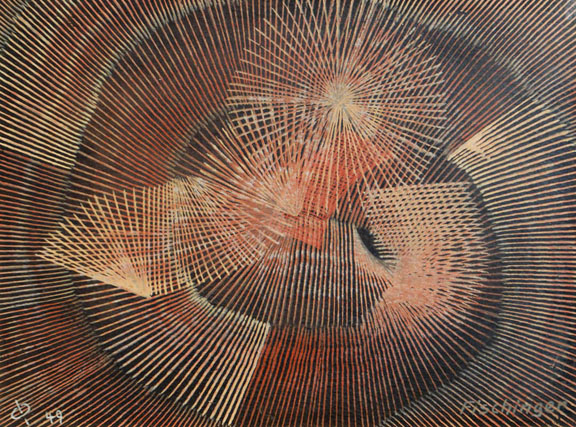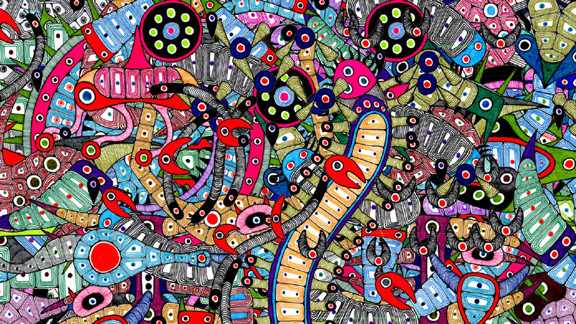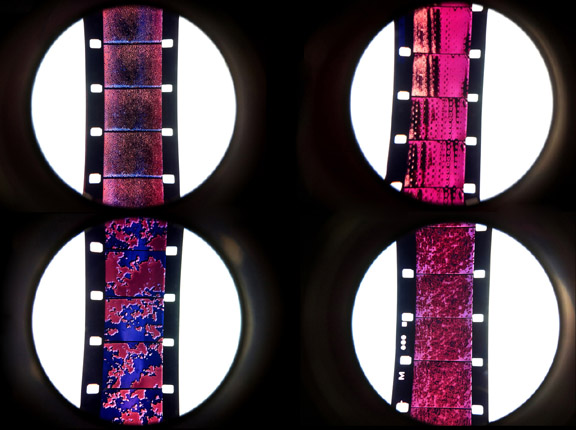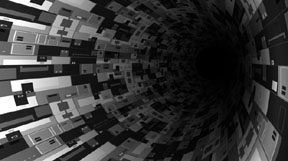ART 381 Experimental Animation
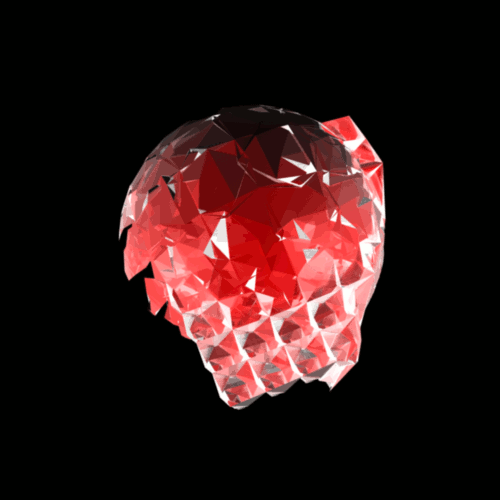
Spring 2014
CSULA
Professor Jim Ovelmen
jim@jimovelmen.com
@calstatela.edu
LAB HOURS (for working labs outside of class)
CAL icon for all DUE DATES
PINK icon for all assignment formatting
TRICOLOR icon to return to ovelmen syllabi
Department of Public Safety/Security 323-343-3700
OfficeFA 227,Office Hours (see syllabi page), PhoneExt. 3-4033, Course Length10 weeks + finals day, Meeting TimeFRIDAY 9:50am-3:20pm,Class LocationFA 225, Term/YearSPRING-2014
Prerequisites: ART 280, ART 378.
COURSE DESCRIPTION
There is a rich history of experimental (non-narrative) animation in Southern California.
ART 381 Experimental Animation provides a laboratory environment that is necessary for students to discover and explore methods of visual expression in animation, while not being tasked with rigid narrative structure.
The course provides a context for students to develop
a unique artistic voice in creative animations that are visually based,
and to experiment with various materials. Throughout the course, students
are encouraged to develop their curiosity and imagination, both crucial
in producing personal, experimental animations.
INSTRUCTIONAL METHODS/CONTENT
(1) Study of the history of experimental
animation in the United States and other countries.
(2) Production of experimental animation projects that
combine materials, approaches, and digital and analog techniques.
(3) Exploration of the use of audio or music as a structure
for experimental animation projects.
(4) Development of creative approaches to content in
experimental animation that provides both creative visual communication
and personal expression.
(5) Research of films, visual art, animation and interactive
art that provides inspiration for mixed media animation environments.
(6) Creation of resources used for experimental animation.
(7) Class critiques that provide content-based feedback
and critical analysis of student projects.
LEARNING OUTCOMES
(1) Demonstrate a strong command of color, composition,
and abstract
image-making for animated projects.
(2) Appreciate and demonstrate an understanding of layered
visual information, and more sophisticated interpretations of timing and
movement.
(3) Experiment with innovative methods in the development
of animation projects, based on a strong background in investigative and
imaginative skills.
(4) Produce animation work that demonstrates a diverse
and wide range of
non-narrative animation techniques.
(5) Pursue original experiments in animation based on
a self-reliant attitude.
STUDENT RESOURCES
technical
STOP MOTION
Dragonframe
AFTER EFFECTS
ART MATERIALS
Stats (decor)
cerebral
FILM FORUM
MOCA
LACMA
SUNDANCE
ANN ARBOR FILM FESTIVAL
INDEPENDENT ANIMATION
ONLINE ART/ANIMATION
youtube
SUGGESTED TEXTS
Anker, Steve; Geritz, Kathy and Seid, Steve. Radical Light: Alternative Film and Video in the San Francisco Bay Area, 1945-2000. University of California Press, 2010.
Brakhage,
Stan and McPherson, Bruce R. Essential Brakhage: Selected Writings on
Film-Making. McPherson, 2001.
Foster, Gwendolyn Audry and Winston-Dixon, Wheeler. Experimental Cinema: The Film Reader. Routledge, 2002.
Furniss, Maureen. Art in Motion: Animation Aesthetics (revised edition). John Libbey Publishing, 2008.
Giambruno, Mark. 3D Graphics & Animation. New Riders Press, 2002.
Good, Howard and Borden, Sandra L. Ethics and Entertainment: Essays on Media Culture and Media Morality. McFarland, 2010.
Perlich, John and Whitt, David. Millennial Mythmaking: Essays on the Power of Science Fiction and Fantasy Literature, Films and Games. McFarland, 2009.
Robinson, Chris. Animators Unearthed: A Guide to the Best of Contemporary Animation. Continuum, 2010.
Rush, Michael. Video Art (second edition). Thames & Hudson, 2007.
Russett,
Robert and Star, Cecile. Experimental Animation: An Illustrated Anthology.
Van Nostrand Reinhold Inc., 1977.
Sitney, P. Adams. Visionary Film: The American Avant-Garde, 1943-2000
(third edition). Oxford University Press, 2002.
Skoller, Jefferey. Shadows, Specters, Shards: Making History in Avant-Garde Film. University of Minnesota Press, 2005.
Turvey,
Malcolm. The Filming of Modern Life: European Avant-Garde Film of the
1920s. The MIT Press, 2011.
Wells, Paul. Animation – Genre and Authorship. Wallflower Press, 2002.
Wells, Paul; Hardstaff, Johnny and Clifton, Darryl. Re-Imagining Animation: The Changing Face of the Moving Image. Ava Publishing, 2008.
REQUIRED SUPPLIES
DICK BLICK 44 South Raymond Avenue Pasadena, CA
91105
(626) 795-4985
scissors, item: 57037-1005
19"x25" Black Canson Art Paper (50 sheets) item: 11273-2002
fadeless Art Paper, (Apple Green) 24"x12 feet (roll) item:12915-7172
white artist tape, 3/4" item: 24124-1034
Polymer Clay, assorted colors (Staedtler Fimo)
exacto knife, item: 57409-0000
cutting matte, 8½" × 12", item: 57522-7512
Portfolio (red wallet), 20" × 26", item: 15105-1001
Acetate bags, 10-pack, 14" × 16", item: 16969-1004
zipper bag, 12" × 16", item: 16974-2016
14"x17" Strathmoore 100-st Sketchpad (about $12)
9"x12" Canson Field Sketchbook (about $13)
Plastic Art Box 12x5x6" (about $5)
100-pack Blank Index cards (no lines)
Large Binder clips
What IS EXPERIMENTAL ANIMATION? and WHY IS IT IMPORTANT to DEVELOPING ANIMATORS?
This class likely will be the most unpredictable animation class you have ever taken. And that is by design.
There is a long rich history of experimental animation right here in Southern California. Artists whose very mode of operation requires that they do not really know what the hell they are making as they are making it...
While this may sound absolutely dismal, or possibly the detrimental attitude of a confused animation student, this can also possibly be something deeper. If the animator is dead serious about his or her involvement with the outcome, and has a structured and dedicated practice and belief, this same statement can reflect something perhaps even profound. The work of The Whitney Brothers, Oskar Fischinger, Larry Cuba, Stan Brakhage, William Kentridge, Jordan Belson, Harry Smith to Mizue Marai, is anything but meaningless and disorganized. Their works are triumphs of vision and imagination, yet their work does not follow narrative convention or guidelines, they simply follow different guidelines.
Simply put, EXPERIMENTAL ANIMATION is work valued mainly on its unique visual strategy or experimental achievements. It does not mean there can never be figures, recognizable things, any hint of a story; or must be pure abstraction. It just means, usually there is limited or no narrative, because this is not the aim of the animation. Most successful animations have a structure and a strategy, but not every animation has a story or requires a storyboard. Americans especially have grown accustomed to thinking that "animation" means only narrative cartoons or features. Anything else often gets dubbed "motion graphics" or screensavers. However, all over the world, there are artists and filmmakers that use space, time, and animated imagery differently than conventional narrative. Animators of this sort build entire careers with their work. They just don't get as well advertised as conventional animation.
In this class we will create experimental animations. I will show you examples of works from all over the world. You will receive specific assignments. You will work both alone and in teams to produce animated work that does not involve explicit narrative, yet is visually captivating, moving, expressive, funny, peculiar, strange, inspired or emotional in an equally dramatic way to any narrative work.
If you don't believe that the practice and appreciation of experimental animation serves overall creativity, just start looking up biographies and quotes of some of the world's most successful animation directors. The ability to work outside the box is experimental. The ability to deliver a completed work on time is professional. Story rules in narrative animation. Yet, wasn't there a first person to create animated characters cut out of paper? Was this not a new and bold move? From Lotte Reineger to even South Park, a tradition begins with someone first trying something new.
Experimentation is the very courage that gives wonder to animation as a phenomenon.
You will HAVE TO TRUST YOUR INSTINCTS, and ALLOW yourself to try new approaches. A strict and conventional approach toward filmmaking will be challenged in this class.
We will learn from the greats in experimental and time-based art and filmmaking, and you will create animated works. Moreover this is a class where you will develop an artistic self-reliance in exploration and visual development. You will be rewarded for evidence of your imagination and artistic exploration primarily in this class. Simply "following the assignment" is not all the point of this class. Bold experimentation within a visual strategy is the point. Use projects descriptions as guidelines only.
Projects are graded based on the effort you put into into the work, and the artistic success of the results. You are also required to visit and write about an event involving experimental filmmaking or video as well as propose a "projection" animation project.
watch these experimental animations:
- Mizue Marai Chaotic Order, Jam, Modern
- Jordan Belson World (excerpt), Bardo(excerpt)
- Harry Everett Smith Abstractions
- Oskar Fischinger Optical Poem
- Stan Brakhage The Dante Quartet
- Jennifer Steinkamp The Wreck of Damaru
- Miwa Matrayek, performance animation
We will be using very diverse tools and approaches to create the experimental animation projects.
We will use physical art materials, direct action, stop motion, as well as CGI and digital animation techniques with MAYA and AFTER EFFECTS to achieve our goals. Because we are not of course living in the 1930's or 70's, our pioneering spirit will match the early experimental animators, yet we will also use contemporary digital software as well.
THE ENTITY PROJECT: ENTITY-1-virtual, ENITITY-2-actual, ENTITY-3-Landscape, FINAL ENTITY= midterm
ENTITY-1-virtual (DUE Week 3)
Homework for due next week: create a flip-book animation with 100 blank index cards. use a LARGE BINDER CLIP to bind one edge. Create a morphing entity flipbook animation. Change its size, shape, or appearance over 100 cards. you may spend 2-3 hours doing this. Don't think too much about what you are drawing, just keep your hand moving and let it freeform. If you have more time, add more detail. Use black markers or micron pen. Color not necessary.
continue working on your ENTITY-part1, and have partial test renders ready for critique
-FLIPBOOK HOMEWORK DUE
-show any render test you have for Entity-part1
-continue to work on Entity-part1, use maya, render, and follow new techniques to prepare for final render.
-begin to gather and organize found materials and objects for stop-motion.
DEMO on DYNAMICS in MAYA, and using particles, rendering and lighting, Demo on tunnel effects in Maya, and other special effects
ENTITY-2-actual (DUE Week4)
choose 4-5 team members. Work together to gather small objects that will be used for Entity-part2
Homework (continued from class) Team member must gather AT LEAST 20 SMALLL items each. Any team member not contributing will be impacted in participation. Each item must be district. Not 20 coins or buttons. Altogether, you should have about 80-100 items.
Do not use toys, or commercial products. Gather PARTS of manmade or natural objects.
You will be using these parts and deciding as a team how to create an "entity" out of it, for "Entity-part2"
you may create abstract or recognizable entities out of the parts. You must follow all the specs, see project description
watch these now!:
David Guetta - Visuals(click)
Amoeba Presents Microglitchmachinefunk(click)
Ellector(click)
Entering The Stronghold(click)
Fire Flower by Pierre Michel (click)
Fleer Ultra.(click)
Dumserum.(click)
Glitch MT(click)
Hello, I Like You (click)
Jemapur - Clarte (click)
Old Black -- Egyptrixx Feat. Ohbijou (click)
Stateless - Ariel (click)
For Homework viewing:
Lotte Rienger
Anthony Lucas
Andy Kennedy
Allison Shchulnik
David Lee
Experimental Japan
Igor Skaletsky and a drummer Evgeniy Labich
Atyp & Si Begg
DUE: ENTITY-PART1
-continue to work on Entity-part2
use glass-shooter, set shooter, etc. to shoot stop motion animations
ENTITY-3-landscape (DUE Week5)
You are to put all these parts together in AFTER EFFECTS
- ENTITY-1 virtual=(Maya/digital animation)
- ENTITY-2 actual=(StopMo animation)
- ENTITY-3 landscape=(Stopmo or CGI motion landscape/tunnel)
- FINAL ENTITY (put all together in After Effects)
You must put the entity on a journey. It is your choice wether you would like to
watch this now:
Automatic Writing, William Kentridge (click)
The Shrine, An Argument (click)
Yonder (click)
Amstell (click)
Kiss, A Love Story (click)
Crazy (click)
Sauvage [Extrait] (prix special du jury pour un film de fin(click)
Red river bay.mp4 (click)
Una Pieza M S - Marian Ruzzi y Sr. Amable(click)
Haven't Been Yourself (click)
Mykonos (click)
Air: Sing Sang Sung (click)
How Lighting changes everything
Animated Surface Alteratives/Projection Alternatives:
Scintillation(click)
Anim - Run by VJsuave(click)
BLU Combo (click)
building mapping (click)
stopmo equipment
Maya
After Effects
Using Camera in After Effects (basic)
After Effects Keyboard Shortcuts
DUE: ENTITY-PART2
FINAL ENTITY (DUE Week6)
Using After Effects, bring all your work together into a final piece.
The Final Entity is to be at least 5 minutes and may contain a music or ambient soundtrack.
Use AFTER EFFECTS to dynamically match and creative compose the different parts of the ENTITY project.
You must color correct, mesh together, and balance all the different segments to seem like one image. Strive for the whole work to map a journey and to not feel repetitive or seem repetitive.
USE THIS DAY TO WORK ON AFTER EFFECTS AND FINALIZE YOUR WORK TO BE PRESENTED AS YOUR MIDTERM at the beginning of week6.
Artist's Wildly different approaches in stop-motion, the medium is the message.Allison Shulnik, stop-motion blog Dragonframe
Media Artists (via Joshua Mosley):
Joshua Mosely (Dread), (Cow to Pascal, Rousseau and Dread)
William Kentridge (Automatic Writing)
DUE: ENTITY-PART3
last production day for FINAL ENTITY project
DUE: FINAL ENTITY
Introduction to FINAL PROJECT
A Fluid Expression
using a combination of all the tools and techniques that you have learned so far, create an experimental animation that does not have or keep definite edges or form.
In contrast to the midterm, where the "Entity" is a "thing" or animated "object", think about a flowing animation, that has no certain boundaries. Think about things that constantly reshape. Liquids, atmospheres, lights, etc., are obvious examples, but you could use actual materials in a very unique way to suggest "fluid".
You are encouraged to combine different techniques from stop motion and experiment with "fluid" materials. It could be anything from milk, to paint, to salt or ink. YOU MUST KEEP AREAS CLEAN/prevent mess and clean up to original state all equipment!
you may work individually or in groups. You should produce about one-minute of animation per person.
no narrative, figures or recognizable imagery is required, however is not prohibited.
you may use music and/or custom sound that matches or enhances the look and feel of your experimental animation
-Due on Finals Day, Friday of Week 11
-HD1080 in size, H.264 compression,
-and at least one minute of animation per person.
Themes:
Even though there is no "story", you need a structure or thematic al idea.
So we will look for examples and themes that have emotional or structural contrast:
-birth and destruction
-growth and decay
-purity and contamination
-ethereal uplift and damnation
-chaos and order.
..come up with your own two opposing emotions or motives for your work!
When you present your final animation on Finals Day, let us know what themes/structure you intended.
See ALL the links on the right, for some ideas, directions and visualization of many kinds of experimental animations that has a flowing nature.
You will be evaluated for how creatively and imaginatively that you achieve the animated results, as well as the technical achievement of your work.
Examples of Experimental Animation and/or ideas for "Fluid Expression"
Erick Oh: Symphany
Paper and projection MOCA Taipei
production on Final project
production on Final project
Stopmo shorts
head over heels, head over heels
scintellation, the shrine, out of a forest, much better now, something left
the deep end, fresh guacamole, street of crocodiles, dimensions of dialog, darkness light, mary and max, clip2, trailer
production on Final project
progress presentation of FINAL PROJECT
FINALS WEEK, May 13 (week 11)
Present FINAL PROJECT FINAL PROJECT is due,
on FINALS DAY:
FRIDAY
ASSESSMENT PROCEDURES
ATTENDANCE
Attendance is mandatory. Any absences not excused by a note from a doctor or a dean will negatively affect your participation grade (see participation below). I will take roll during every class. If you have an illness or family emergency that prevents you from attending class, you need to contact me as soon as possible (e-mail is usually the surest way). If you are late for class, it is your responsibility to make sure I don't have you recorded as absent. If you miss a class for any reason, whether excused or unexcused, it is your responsibility to contact someone from class to find out what you missed (do this before the next class meeting). You are also responsible for getting copies of any handout that was given out in your absence. After your second unexcused absence, any additional absence will knock 30 points off of your final grade (see Grade Scale below for the points scale for this class).
PARTICIPATION
Your participation will be evaluated using the following criteria:
-Doing the reading assignments before we discuss them.
-Active participation in all small-group work.
-Speaking in class discussions.
-Listening (in the active sense).
Your participation grade will be negatively affected by any of the following (this is a short list):
-Leaving on your electronic devices. All laptops, cell phones, pagers, and other electronic devices should be turned off and put away during class. This includes earphones and earpieces.
-Coming to class late and/or leaving class early.
-Failure to do the homework on time.
-Absences.
-Talking about non-course-related subjects during group activities.
- Talking during video screenings and/or while someone else has the floor.CLASS POLICIES
Missing even one class is enough to put you significantly behind. Regular class attendance in mandatory. Class attendance is also part of your class participation grade. Arriving on time is equally important. You would be fired in a job you do not show up. The expectation here is similar. You will be considered absent one class period for every two tardies. (more than five minutes late)
Missing 3 classes, consecutively or not) is an AUTOMATIC FAILURE for the class.
Expect to spend from three to six hours a week on your working outside of class. Lab hours will be available and posted by the end of the first week.
Students are responsible for any material missed due to tardiness or absence. Readings, and assignments, and projects are expected at the beginning of class on their due dates.
Late submissions will be lowered one grade per class day late.
student may be able to re-submit any assignment for an improvement grade. The policies are specific to each assignment. Check specific project descriptions for more details.
METHOD OF EVALUATION
Homework assignments will be given points based on accurate completion of assigned readings, assignments and tutorials.
The Midterm and the Final project will graded based on these criteria:
*Quality of Movement/Timing
*Visual Appeal
*Technical Effectiveness
*Originality/Creativity
Each given an equal weight to compose your grade for each project
It is, of course, the responsibility of each to ensure his/her work in completed an handed in on due dates (see below)
Critical review of your work will provide the source most assessments. Participation grade includes the extent and quality of the participation in the critiques, presentation of projects and positive interaction with classmates and professional approach toward the class. Students requiring any kind of special assistance should speak with the instructor at their earliest
ASSIGNMENTS
Paticipation and Homework % 10
Experimental Film/Animation Event Report %5
Experimental Projection Proposal %5
Entity part1: %10
Entity part 2, 3, and Final Entity (MIDTERM) %35
Final Project %35
GRADE SCALE: A 90%-100%B 80%-89%C 70%-79%D 60%-69%F Below 60%
MAKE UP WORK
Late assignments, or absences due only to emergency or illness may be granted leniency only per the instructor's discretion.
Extra Credit:
Students may be able to re-submit any assignment for an improvement points as long as that assignment was turned in the original due date. The policies are specific to each assignment. Check specific project descriptions for more details.
Other opportunities for extra credit are possible involving visiting realted exhibits, films, museums, specific research, attending relevant shows or conferences, or related study, etc. Such points are limited and per the instructor's discretion
ALL ASSIGMENTS ARE DUE AT THE BEGINNING OF CLASS. CLICK THE CALENDAR BELOW FOR ALL DUE DATES
